Advertisements
Advertisements
प्रश्न
A plane EM wave travelling in vacuum along z direction is given by `E = E_0 sin(kz - ωt)hati` and `B = B_0 sin(kz - ωt)hatj`
- Evaluate `oint E.dl` over the rectangular loop 1234 shown in figure.
- Evaluate `int B.ds` over the surface bounded by loop 1234.
- Use equation `oint E.dl = (-dphi_B)/(dt)` to prove `E_0/B_0` = c.
- By using similar process and the equation `ointB.dl = mu_0I + ε_0 (dphi_E)/(dt)`, prove that c = `1/sqrt(mu_0ε_0)`
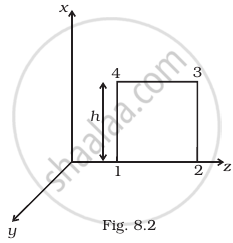
उत्तर
i. Let electromagnetic wave is propagating along z-axis, in the case electric field vector `(vecE)` be along x-axis and magnetic field vector `(vecB)` along y-axis i.e., `vecE = E_0 hati` and `vecB = B_0 hatj`.
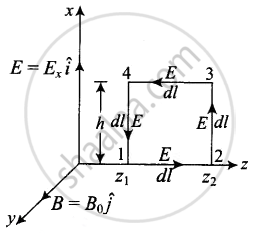
The line integral of `vecE` over the closed rectangular path 1234 in x-z plane of the figure is
`ointvecE*dvecl = int_1^2 vecE*dvecl + int_2^3 vecE*dvecl + int_3^4 vecE*dvecl + int_4^1 vecE*dvecl`
= `int_1^2 E*dl cos 90° + int_2^3 E*dl cos 0° + oint_3^4 E*dl cos 90° + int_4^1 E*dl cos 180°`
`oint vecE*dvecl = E_0h [sin (kz_2 - ωt) - sin(kz_1 - ωt)` .....(i)
ii. Now let us evaluate `int vecB*dvecs`, let us consider the rectangle 1234 to be made of strips of are `ds = hdz` each.
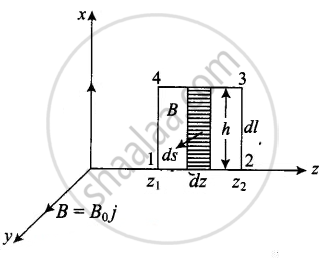
`int vecB * dvecs = int B*ds cos 0 = int B*ds`
= `int_(Z_1)^(Z_2) B_0 sin (kz - ωt)hdz`
`int vecB*dvecs = (-B_0h)/k [cos (kz_2 - ωt) - cos (kz_2 - ωt)]` ......(ii)
iii. We are given `ointE*dl = (-dphi_B)/(dt) = - d/(dt) oint B*ds`
Substituting the values from equation (i) and (ii), we get
`E_0h [sin (kz - ωt) - sin (kz_1 - ωt)] = (-d)/(dt) [(B_0h)/k cos (kz - ωt) - cos (kz_1 - ωt)]`
= `(B_0h)/k ω [sin (kz_2 - ωt) - sin (kz_1 - ωt)]`
⇒ `E_0 = (B_0ω)/k = B_0c` .....`[because ω/k = c]`
⇒ `E_0/B_0 = c`
iv. For evaluating `oint vecB.dvecl`, let us consider a loop 1234 in y-z plane as shown in figure given below.
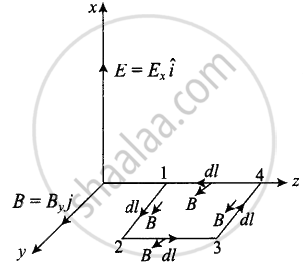
`oint vecB*dvecl = int_1^2 vecB*dvecl + int_2^3 vecB*dvecl + int_3^4 vecB*dvecl + int_4^1 vecB*dvecl`
= `int_1^2 B*dl cos 0° + int_2^3 B*dl cos 90° + int_3^4 B*dl cos 180° + int_4^1 B*dl cos 90°`
`oint vecB*dvecl = B_0h [sin (kz - ωt) - sin (kz_1 - ωt)]` ......(iii)
Now to evaluate `phi_E = int vecB*dvecs`, let us consider the rectangle 1234 to be made of strips of area hds each.
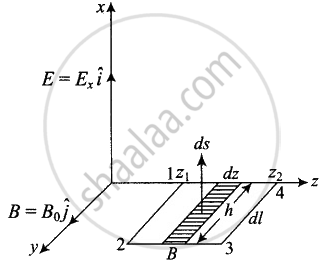
`phi_E = int vecE*dvecs = int Eds cos 0 = int Eds`
= `int_(z_1)^z E_0 sin (kz_1 - ωt)hdz`
`oint vecE * dvecs = - (E_0h)/k [cos (kz_2 - ωt) - cos (kz_1 - ωt)]`
∴ `(dphi_E)/(dt) = (E_0hω)/k [sin (kz_1 - ωt) - sin (kz_2 - ωt)]` .....(iv)
Let `oint B*dl = mu_0(I + (ε_0dphi_E)/(dt))` where I = conduction current = 0 in vacuum
∴ `oint B*dl = mu_0ε (dphi_E)/(dt)`
Using relations obtained in equation (iii) and (iv) and simplifying, we get
`B_0 = E_0 (ωmu_0ε_0)/k`
⇒ `E_0/B_0 ω/k = 1/(mu_0ε_0)`
But `E_0/B_0 = c` and `ω = ck` ⇒ `c*c = 1/(mu_0ε_0)`,
Therefore `c = = 1/(mu_0ε_0)`
APPEARS IN
संबंधित प्रश्न
Draw a schematic sketch of the electromagnetic waves propagating along the + x-axis. Indicate the directions of the electric and magnetic fields
The amplitude of the magnetic field part of a harmonic electromagnetic wave in vacuum is B0 = 510 nT. What is the amplitude of the electric field part of the wave?
Identify the electromagnetic waves whose wavelengths vary as:
(a) 10–12 m < λ < 10–8 m
(b) 10–3 m < λ < 10–1 m
Write one use for each.
Arrange the following electromagnetic waves in order of increasing frequency:
ϒ-rays, microwaves, infrared rays and ultraviolet rays.
What are the directions of electric and magnetic field vectors relative to each other and relative to the direction of propagation of electromagnetic waves?
State any one property which is common to all electromagnetic waves.
Write notes on Gauss' law in magnetism.
Write a short note on the microwave.
Which one of the following does not represent simple harmonic motion? Here y denotes the instantaneous displacement. Here, A and B are constants and co is the angular frequency.
Dimensions of 1/(µOE0) is
